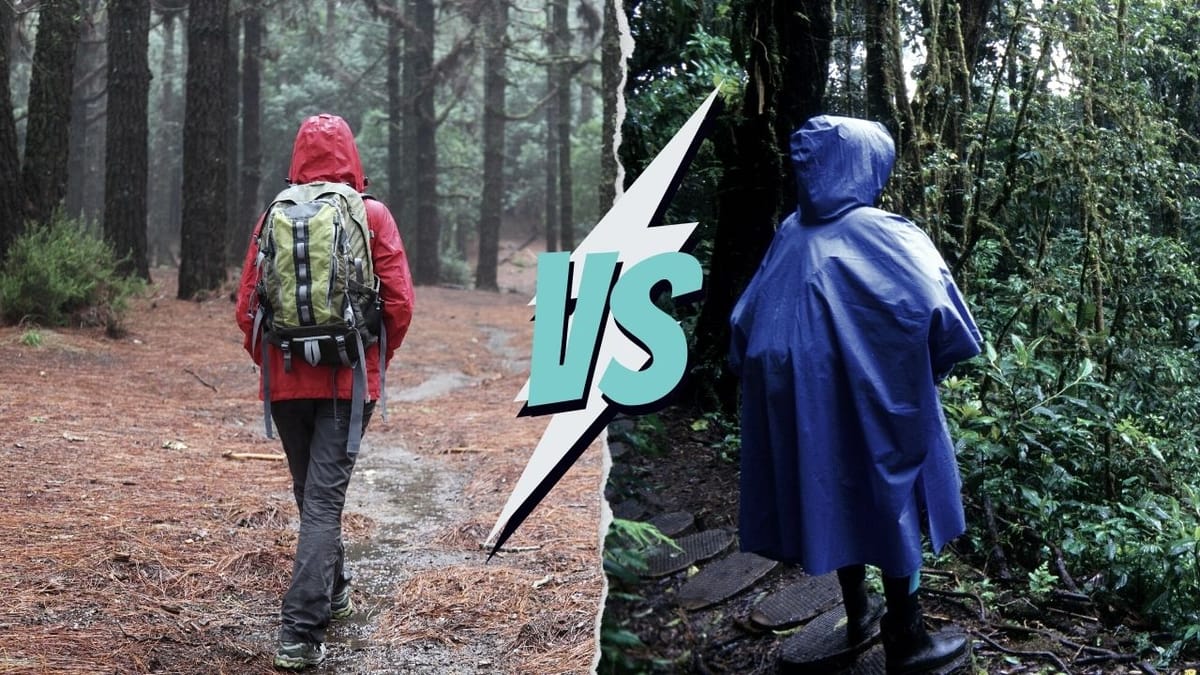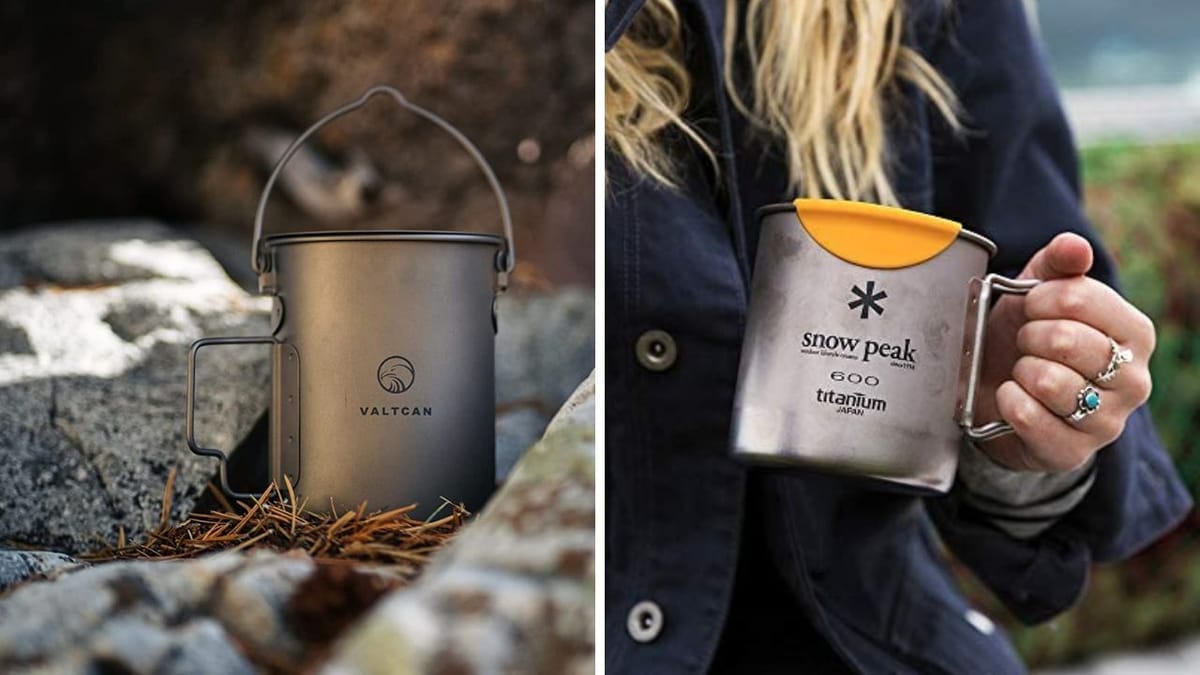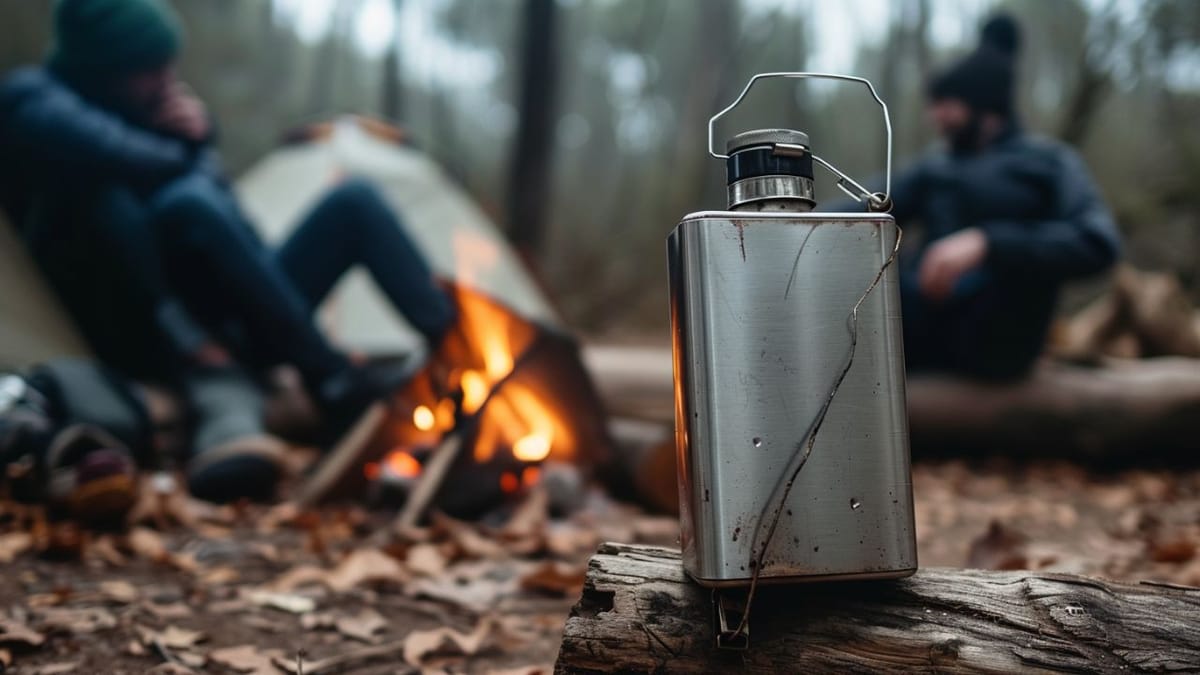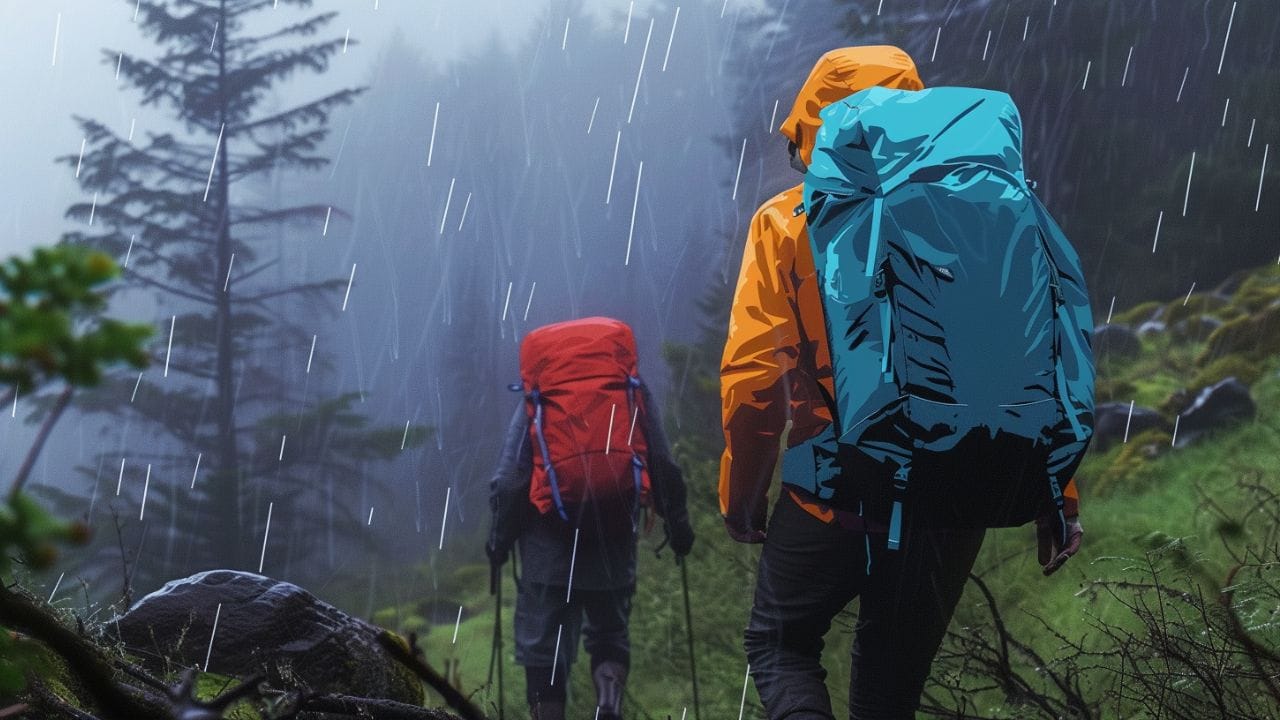
Backpacking in the Rain: Essential Tips for a Dry Adventure
Backpacking in the Rain? No problem! Get top tips for waterproof gear and strategies to enjoy the wet wilderness.
Backpacking in the rain brings a unique set of challenges and rewards, transforming the familiar trails into a different world altogether. Rain intensifies the colors of nature, the sound of droplets creates a rhythm, and the scents of wet earth and vegetation become more pronounced.
Yet, without proper preparation and know-how, what could be an invigorating experience may turn into an uncomfortable and potentially unsafe trek.
Understanding how to effectively navigate and enjoy the wet conditions is crucial for any backpacker.
From the right gear to keep you dry to knowing how to set up a rain-proof camp, the skills required diverge somewhat from fair-weather hiking. Knowledge of weather patterns is fundamental to planning, while strategies for hiking through wet conditions are necessary for both comfort and safety.
Moreover, considerations such as minimizing environmental impact and dealing with potential emergencies under these circumstances are paramount. The art of staying dry, warm, and maintaining high spirits despite the rain is a rewarding part of the backpacking adventure that requires foresight and adaptability.
Key Takeaways
- Proper preparation and understanding of wet conditions are essential for a safe and enjoyable backpacking experience in the rain.
- Selecting the right gear and mastering hiking strategies can help maintain comfort and safety on rain-soaked trails.
- Responsible practices and emergency preparedness are critical to minimizing environmental impact and ensuring well-being during rainy backpacking trips.
Understanding Weather Patterns

Before heading out on a rain-soaked backpacking adventure, it's vital to grasp how to interpret weather forecasts and identify areas likely to experience rain.
Reading Weather Forecasts
Weather forecasts are a crucial tool for backpackers. One should meticulously examine the forecast for their destination before departure.
Understanding weather patterns for safe hiking and camping involves recognizing the expected temperatures, wind conditions, and precipitation chances. Pay close attention to any advisories or warnings that can impact your planned route.
Recognizing Rain-Prone Areas
Certain landscapes are more susceptible to rainfall, especially mountainous regions where orographic lift can cause clouds to release precipitation.
Valleys and areas near bodies of water may also have higher humidity levels, which can lead to rain. Backpackers should research their route’s terrain and consider the environment when planning their trip to anticipate and prepare for wet weather conditions.
Essential Gear for Rainy Backpacking
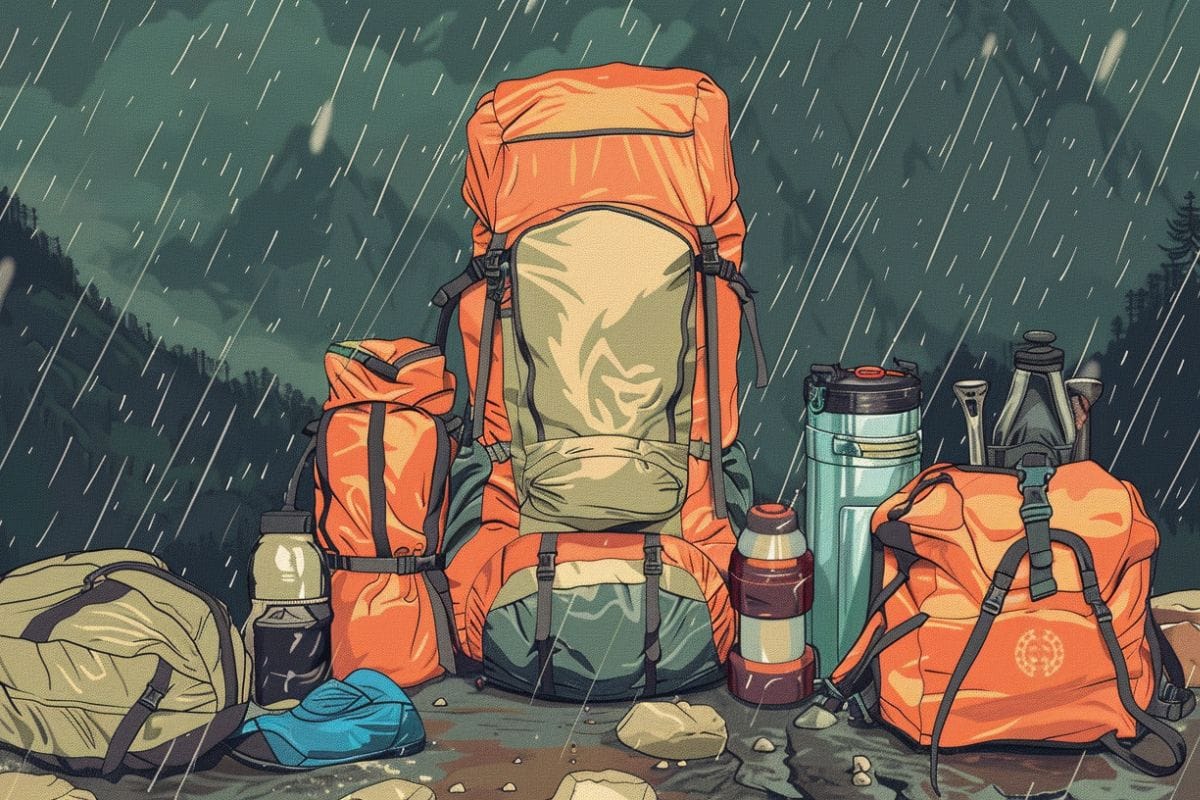
When planning a backpacking trip in wet weather, selecting the right gear is crucial to stay dry and comfortable. Waterproof and water-resistant equipment is a must-have in every hiker's pack to tackle the rain with confidence.
Waterproof Backpack
A hiker should choose a waterproof backpack to ensure their belongings stay dry even during heavy downpours. A high-quality backpack with sealed seams and a rain cover is essential. The right backpack will protect gear from moisture, keeping everything inside dry.
Rain Covers
In addition to a waterproof backpack, rain covers are indispensable for protecting backpacks that are not fully waterproof. These covers are lightweight and can be easily slipped over a pack to repel water. They often come in various sizes to match different backpack volumes, making them versatile for any trip.
Water-Resistant Clothing
Hikers should wear water-resistant clothing, such as a breathable rain jacket and pants made from fabrics like Gore-Tex or eVent. These materials not only keep the rain out but also allow moisture from the body to escape, preventing overheating.
Footwear Considerations
Proper footwear is a cornerstone of comfort for rainy backpacking. Waterproof boots with a sturdy grip are recommended to prevent slipping and keep feet dry. Additionally, quick-drying, non-cotton socks are beneficial for keeping feet comfortable, even when traversing wet trails.
Setting Up Camp in the Rain
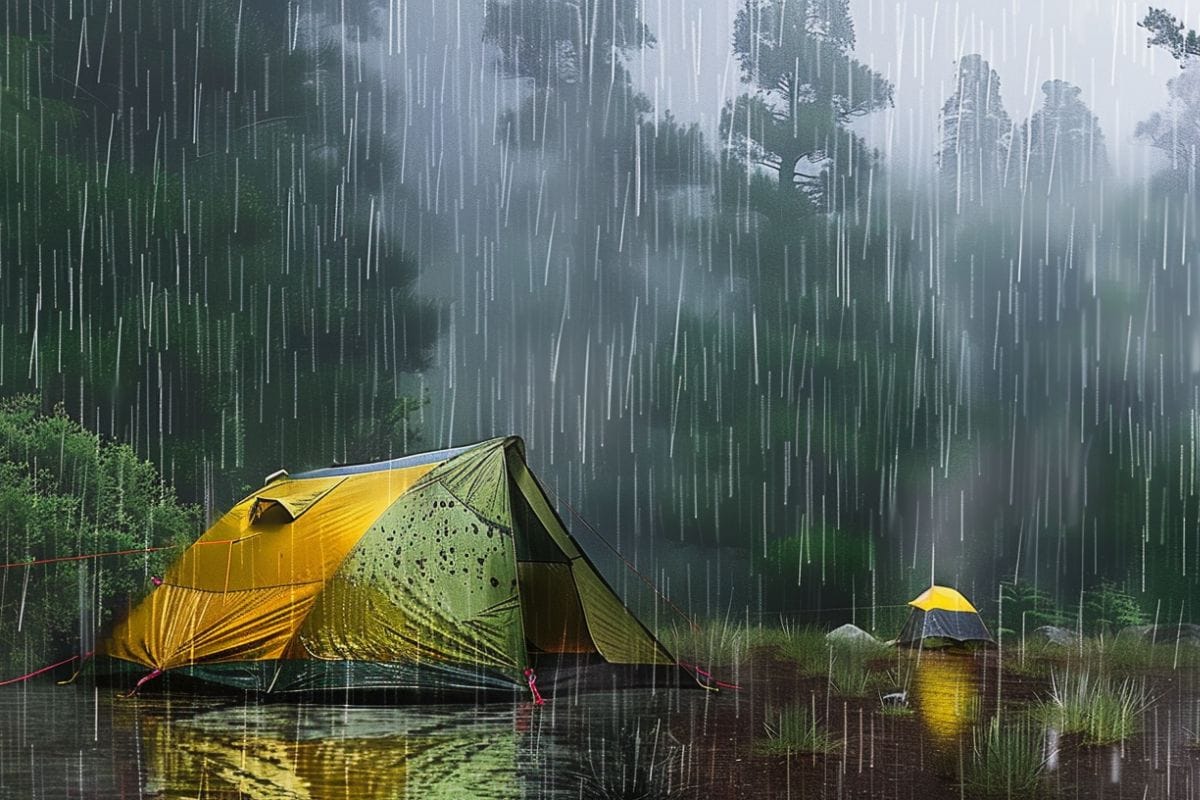
When backpacking in wet weather, establishing a dry campsite is both a skill and an art. The following tips focus on selecting the right location, erecting your tent to stay dry, and managing water effectively.
Choosing a Site
One should look for a higher ground that avoids paths of natural water runoff. It's also advisable to avoid the base of hills where water can collect. Sheltering near trees can offer additional cover, but one should be cautious of the potential hazard from falling branches.
Tent Setup Tips
Setting up a tent in the rain requires a thorough approach. One should aim for quick and efficient methods like rolling the fly inside of the tent to keep the interior dry as it is assembled. If possible, a quick-to-pitch tent design with minimal exposed inner fabric during setup can significantly reduce dampness inside.
Managing Water Runoff
Planning for water flow around the tent is critical. Trenching is generally discouraged due to environmental impact, so one might instead create a simple barrier with a tarp or footprint to divert surface water away from the sleeping area. It's also key to ensure that any rain gear and wet clothing are stored in a way to prevent interior moisture buildup.
Hiking Strategies in Wet Conditions
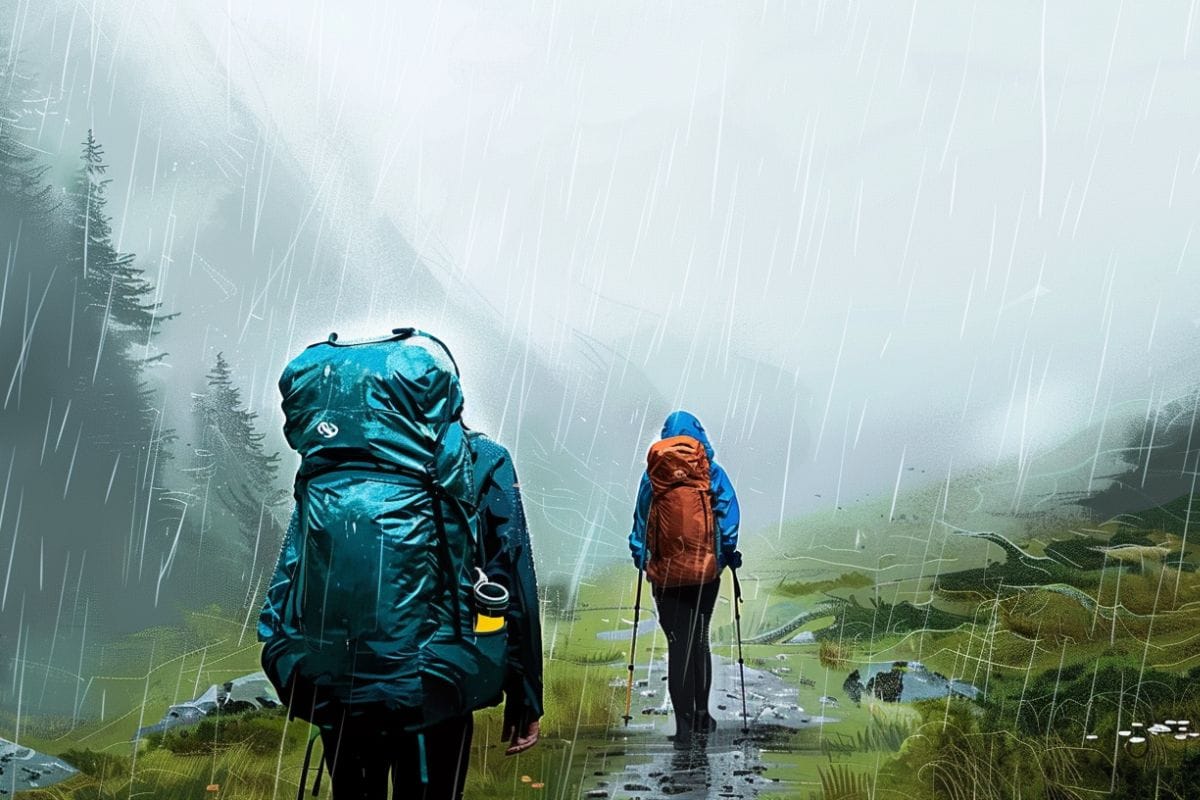
When backpacking in the rain, hikers must adapt their pacing to maintain energy and ensure safety on slippery trails. Proper planning and tactics reduce risks and enhance the outdoor experience despite wet weather.
Pacing and Energy Management
In wet conditions, maintaining a steady and sustainable pace is crucial to prevent exhaustion. Hikers should monitor their energy levels, taking breaks as needed to consume high-energy foods and stay hydrated.
It's also beneficial to manage body heat through the strategic layering of clothing. Fast-paced hiking can lead to overheating, while a too-slow pace may increase exposure time to the elements.
Trail Safety
On slippery and muddy trails, hikers must prioritize safety. They should:
- Use trekking poles for additional stability.
- Look for footwear with deep lug soles for improved traction on slippery rocks and logs.
- Be aware of their surroundings, avoiding areas prone to slides or falling debris.
- Cross streams with care, as water levels can rise rapidly and currents can be stronger than they appear.
Staying Dry and Warm
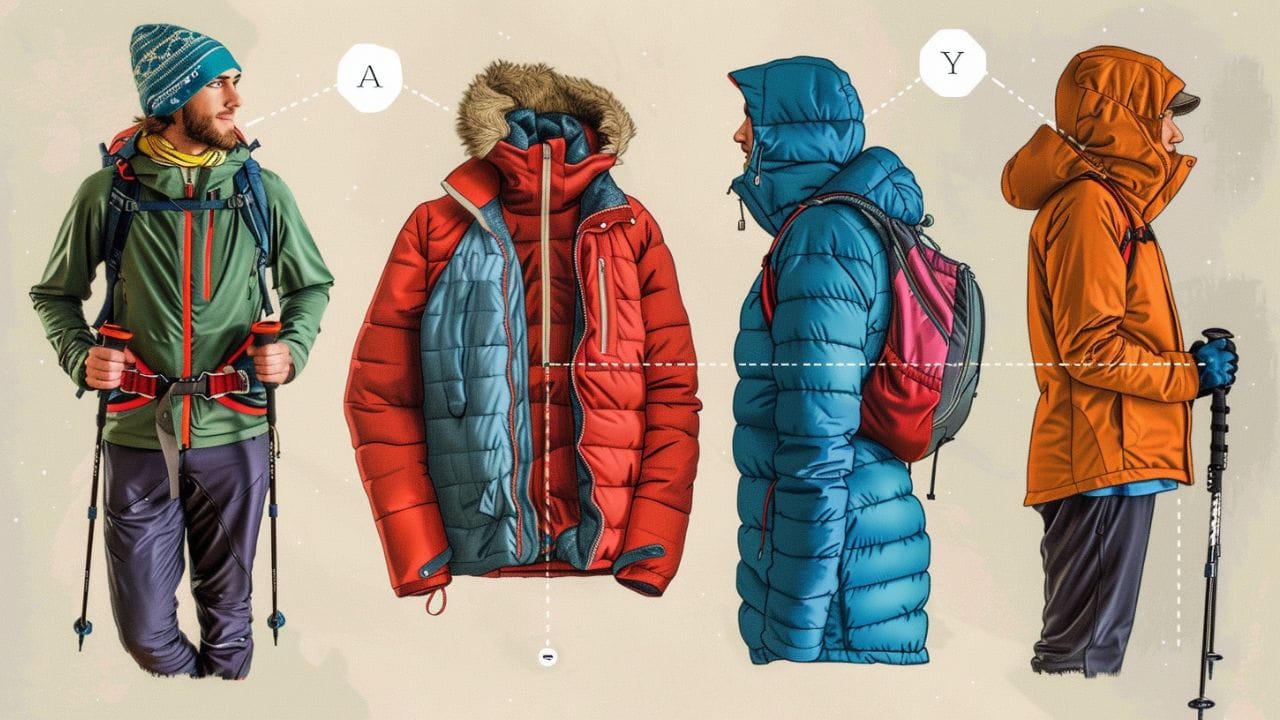
When backpacking in the rain, the hiker's comfort and safety depend on staying dry and warm. Proper layering and hypothermia prevention are crucial to a successful rainy outdoor adventure.
Layering Techniques
A hiker should start with a moisture-wicking base layer that keeps the skin dry by drawing sweat away. Over this, they need an insulating layer, typically made of fleece or wool, which retains body heat.
The outermost layer should be a waterproof and breathable shell that fends off rain while allowing moisture to escape. It's important that none of the layers are too tight, as this can restrict blood flow and reduce insulation.
Hypothermia Prevention
To prevent hypothermia, they must keep their core temperature stable by avoiding wet clothes and staying insulated. If they become wet, changing into dry clothes quickly is imperative.
Waterproof gear, such as rain covers, and accessories, like waterproof gloves and hats, are also essential. They should consume warm, high-energy food and drinks to help maintain body warmth.
Regular movement keeps the blood circulating, but they should also take breaks in sheltered areas to avoid overexertion, which can lead to sweating and subsequent chilling.
Cooking and Food Storage
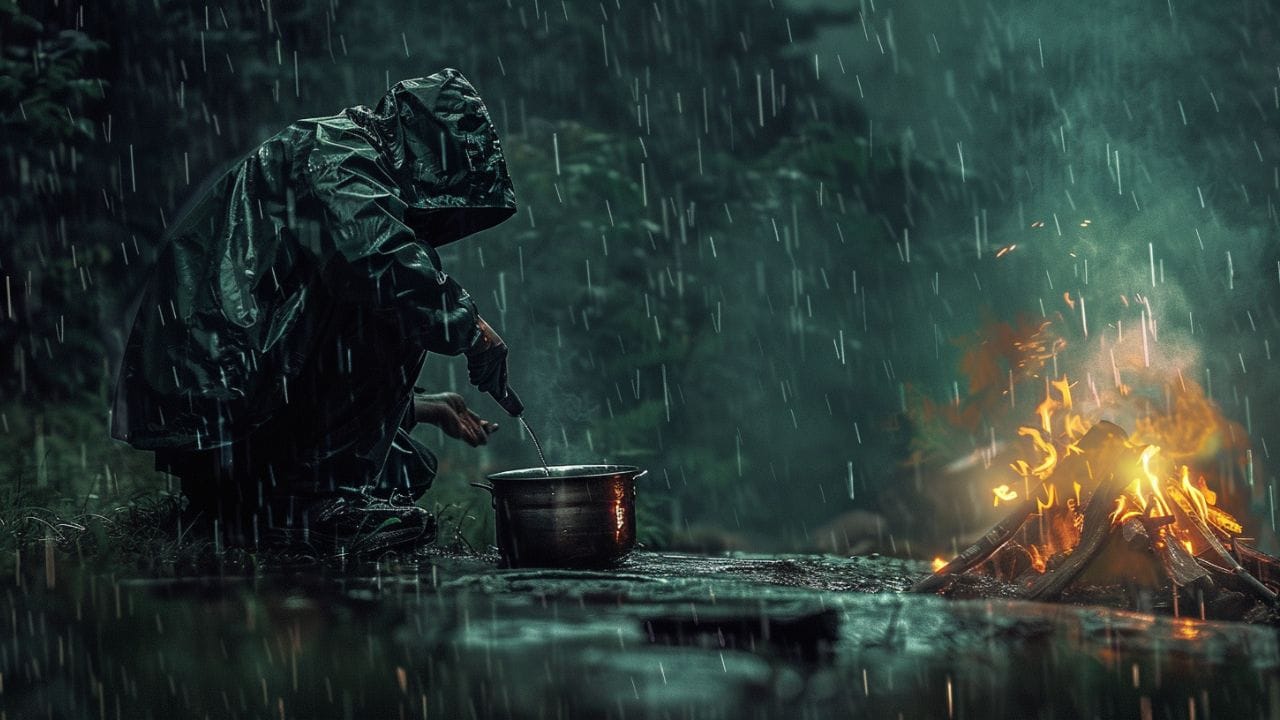
When backpacking in rainy conditions, keeping food dry and cooking safely are crucial. Wet food can spoil or become inedible, and improper cooking practices can be dangerous.
Protecting Food from Moisture
- Use Waterproof Containers: Sealing food in airtight, waterproof containers ensures moisture doesn’t seep in.
- Store in Plastic Bags: For added protection, one can double bag food items using zip-top plastic bags.
Safe Cooking Practices
- Choose Appropriate Shelter: Setting up a tarp or utilizing a sturdy trekking umbrella can provide the needed cover to cook in the rain without dousing the stove flame.
- Ventilation is Key: When cooking under shelter, ensure there is sufficient airflow to prevent condensation buildup and manage carbon monoxide, especially when using fuel stoves.
Environmental Impact and Ethics

When backpacking in the rain, one should consider their environmental footprint and adhere to ethical practices in the wilderness. These considerations help preserve the natural environment and ensure that it can be enjoyed by future backpackers.
Leave No Trace Principles
The Leave No Trace principles are critical for reducing the impact on the environment while backpacking, especially in rainy conditions.
They should carefully plan their trip and choose gear that minimizes their impact, selecting items that are both durable and environmentally friendly.
There are key principles such as traveling and camping on durable surfaces to prevent erosion and degradation of trails, which can be exacerbated by rain.
- Plan Ahead and Prepare: Research the area and weather conditions; avoid sensitive habitats.
- Travel and Camp on Durable Surfaces: Stick to established trails and campsites to reduce soil damage.
- Dispose of Waste Properly: Pack out all trash and use toilets or dig cat holes far from water sources.
- Leave What You Find: Do not disturb cultural or natural artifacts and features.
- Minimize Campfire Impact: Use a stove for cooking and consider campfire alternatives.
- Respect Wildlife: Observe animals from a distance and do not feed them.
- Be Considerate of Other Visitors: Maintain a low profile and let nature's sounds prevail.
Minimizing Campsite Damage
Minimizing campsite damage is essential, and backpackers should set up their campsite with thoughtfulness. In rainy conditions, they must be even more diligent.
- Selecting a Campsite: Aim to find a spot that is not prone to flooding and has natural drainage. Avoid camping in meadows or on vegetation.
- Tent Placement: Place tents on durable surfaces and use a groundsheet to protect the ground from becoming compacted or muddy.
- Managing Water Runoff: Create small trenches to divert water away from the tent and sleeping area if necessary, but ensure they do not cause erosion.
By following these principles and practices, backpackers can enjoy the beauty of the outdoors in the rain without leaving a lasting negative impact on the environment.
Dealing with Emergencies

When backpacking in the rain, a hiker must be prepared for emergencies. This involves having a solid understanding of first aid and effective methods for signaling for help in dire situations.
First Aid Considerations
A well-stocked first aid kit is crucial for addressing injuries quickly. It should contain:
- Sterile gauze and adhesive tape for wound management
- Blister treatment supplies like moleskin or hydrocolloid bandages
- Tweezers and antiseptic wipes for tick removal and wound cleaning
In addition, backpackers should be aware of the signs of hypothermia—an elevated risk in wet conditions—which include uncontrollable shivering, confusion, and sluggish responses. Hypothermia requires immediate action: finding shelter, warming the person, and seeking rescue if necessary.
Emergency Signaling
When lost or in need of rescue, a hiker should have reliable means of signaling. This includes:
- Whistles: Always carry a loud whistle as they are far-reaching and can be used with minimal effort.
- Emergency Beacons: GPS-enabled devices like PLBs (Personal Locator Beacons) or satellite messengers that send distress signals to rescue services.
Using bright clothing or emergency blankets can also make it easier for rescuers to locate someone from a distance. Remember, three of anything (e.g., three whistle blasts) is the universally recognized distress signal.
Post-Trip Care and Maintenance
Taking proper care of your gear post-trip ensures its longevity and reliability for your next adventure. Attending to any water damage promptly can save you time and money in the long run.
Gear Cleaning and Storage
After backpacking in the rain, it's essential to clean all gear thoroughly. For items like backpacks and clothing, use a mild detergent and ensure they are completely dry before storing to prevent mildew. Tents should be set up to air out, even if they were packed dry, to ensure every fold and seam is moisture-free.
- Backpack: Wipe down with a damp cloth; air dry.
- Clothes: Wash according to the tag’s instructions; air dry.
- Tent: Sweep out any debris, spot clean, and air dry fully before packing away.
Storing gear in a cool, dry place away from direct sunlight helps maintain its integrity. Using breathable storage bags rather than airtight ones allows materials to stay ventilated.
Water Damage Repair
Should any gear suffer from water damage, immediate action can help mitigate issues.
For waterproof items like rain jackets or tarps, look for any signs of peeling or flaking, which can indicate the need for re-waterproofing treatments. Leaking seams can often be resealed using a seam sealer designed for outdoor gear.
- Repair kits: Handy for patching up small tears in fabrics.
- Seam sealer: Apply as directed on leaking seams to reinforce waterproofing.
Electronics, if damp, should be turned off and dried out as quickly as possible, with batteries removed to prevent further damage. Rain-soaked books or maps can be dried using absorbent paper between pages and laid flat.
Frequently Asked Questions
Navigating the trails during a downpour requires extra preparation and the right gear. These frequently asked questions provide guidance on what to include and consider when backpacking in the rain.
What should I pack in my hiking kit to be prepared for rain?
To stay prepared for rain, one should pack waterproof gear such as a rain jacket, pants, and a reliable rain cover for their backpack. It's also wise to include quick-drying clothing and waterproof bags to protect electronics and other essentials.
How can I ensure my backpack stays dry during a rainy college commute?
Ensuring a backpack stays dry during a rainy commute can be managed by using a backpack rain cover or selecting a waterproof backpack. Additionally, storing items in sealed plastic bags inside the backpack offers an extra layer of protection.
Are there special considerations for setting up camp when backpacking in wet conditions?
Setting up camp in wet conditions involves choosing a site with good drainage and avoiding low areas where water may pool. One should use a waterproof tent with a full-coverage rain fly and consider a tarp or footprint underneath for added moisture protection.
What's the most effective way to cook outdoors when it's raining?
Cooking outdoors when it's raining can be tackled by using a camp stove with a wide and stable base. Protect the cooking area with a tarp, ensuring it is high enough to prevent any fire hazard, and keep fuel canisters dry.
How important are rain pants for staying comfortable and dry on a backpacking trip?
Rain pants are very important in maintaining comfort and keeping dry, as they provide crucial protection for the lower body that is often exposed to splashes and mud. They should be breathable to prevent condensation and crafted with durable, waterproof materials.
What are some tips for conditioning and training for backpacking in less-than-ideal weather conditions?
To condition for backpacking in challenging weather, one should train with a weighted pack to simulate the added challenge of wet gear. They may also practice hikes in various conditions to get accustomed to navigating slippery trails and maintaining morale in the face of inclement weather.
Before You Go...
